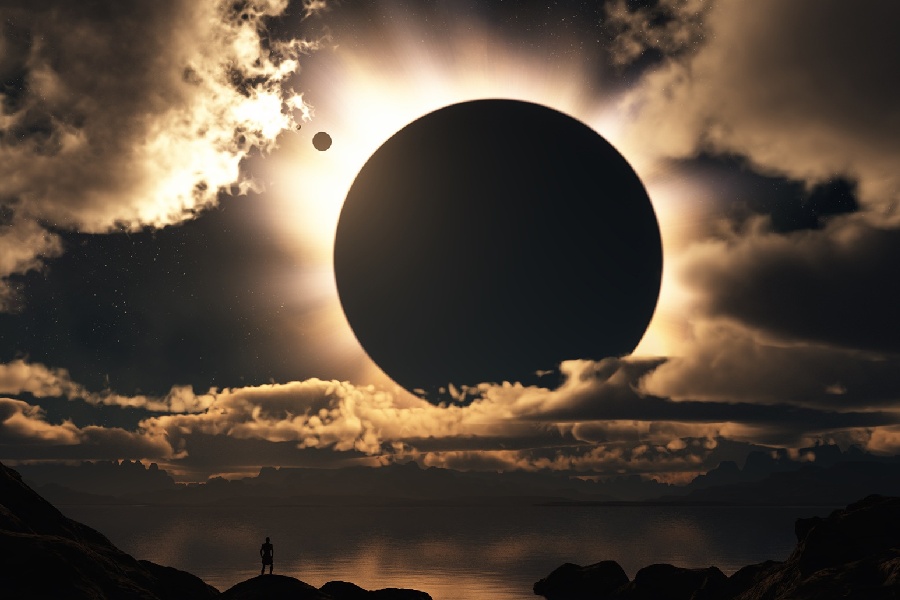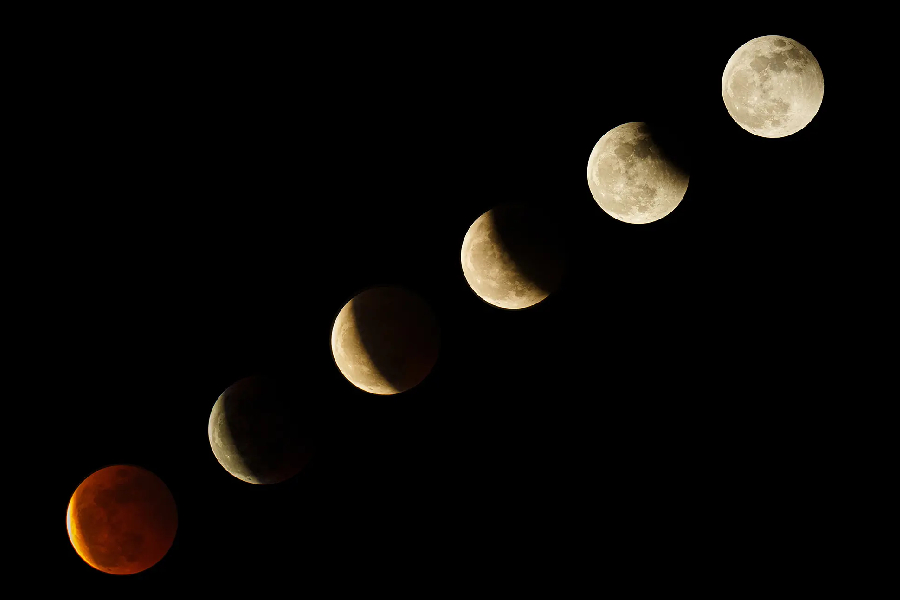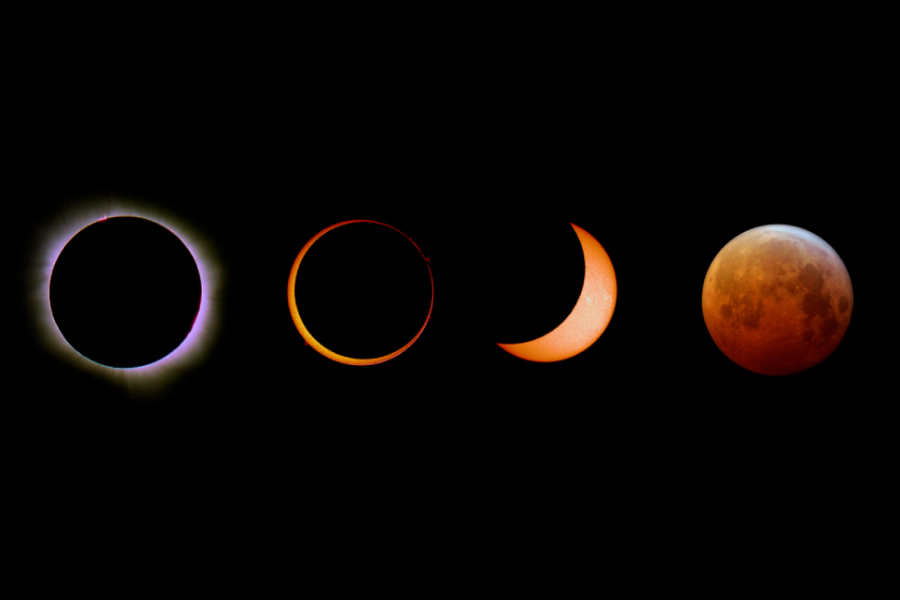Have you ever witnessed the very sun disappear before your eyes? As the daylight rapidly dims, shadows shift, and an eerie cold descends. A solar eclipse looks like magic and mystery happening in the skies above. But what causes solar eclipse? Why does a solar eclipse happen?
Get ready to discover exactly the celestial mechanics behind the solar eclipse spectacle. We will chart how orbital motions position the Moon to cast its shadow onto Earth’s surface at the right moment.
What Causes Solar Eclipse?
Solar eclipses occur due to a special celestial alignment. The Moon orbits between the Earth and the Sun periodically. This enables the Moon’s shadow to fall onto the Earth’s surface.
For a solar eclipse alignment to transpire, the Moon must pass directly in front of the Sun relative to Earth. Precise tuning of all three orbital cycles allows for a straight-line alignment of the Sun, Earth, and Moon. The blocking of sunlight results in partial or total solar eclipses that we can observe from our planet’s vantage point.

The Mechanics Behind Solar Eclipses
In a complex gravitational dance, the Moon orbits the Earth, while the Earth, in turn, orbits the Sun. This periodic alignment allows the Moon to pass directly from the Earth’s vantage point before the Sun. A solar eclipse manifests when the Moon’s shadow lines up to sweep across the Earth’s surface.
The mechanics of a solar eclipse involve a delicate process dictated by celestial cycles and spheres. This precise tuning occurs between the Sun, Moon, and Earth, creating brief alignments. During these alignments, the Moon blocks sunlight from reaching the Earth for a short time, thanks to their relative sizes and the laws of physics.
Sun-Moon-Earth interplay
The occurrence of total solar eclipses is influenced by the almost equal sizes of the Sun and the Moon when viewed from Earth. When these celestial bodies align perfectly, it creates the illusion of the Moon completely covering the Sun for a brief period. This captivating event is possible due to their similar disk diameters and consistent orbital patterns.
Furthermore, the timing of cycles governs the potential for eclipses. For a total solar eclipse to happen, the alignment of the new Moon must be close to a node crossing point, creating a precise Sun-Moon-Earth alignment. This periodic synchronization results in a straight-line alignment, where the shadow of one celestial body falls upon another.
Establishing a foundation for understanding
At cosmic scales, the laws of physics govern gravitational forces and orbital motions between celestial bodies. Through the principles of conservation that preserve momentum, these bodies predictably attract each other due to relativity.
From a different perspective, the occurrence of a total solar eclipse can be viewed as a result of intricate celestial choreography. The harmonious cycling of heavenly orbs unfolds a cosmological order, showcasing the interplay of light and shadows.
Path of Totality
Definition and significance
The path of totality indicates the area where a total solar eclipse completely covers the Sun’s disk. This narrow strip is where the Moon’s inner shadow touches Earth, resulting in a brief “midday darkness” experience. Only places within this path get to witness the wonders of this phenomenon.
So, people within the path of totality enjoy awe-inspiring eclipse views and notice changes in the weather during the moments when the Moon completely blocks the sunlight. Daylight undergoes a temporary transformation before the Sun re-emerges, creating a captivating celestial spectacle.
Geographic regions for optimal viewing
Upcoming total solar eclipses will offer opportunities across select global areas to experience the totality’s splendor based on the path orientation. For instance, on April 8, 2024, a path will cross the central United States and Eastern Canada.
The paths of total solar eclipses differ each time due to the small, rapidly moving umbra shadow falling in various directions. Thanks to careful coordination, eclipse chasers around the world can intercept and marvel at the moments of totality whenever they occur nearby.
Immersive experience within the path of totality
Step into the extraordinary path of a solar eclipse, where astonishing sights unfold. Stars briefly appear as the solar corona emerges around the obscured Sun, creating a captivating celestial spectacle. In these moments, people might even hear shockwaves as the light dims.
Being within this relatively small path triggers intense reactions within both bodies and minds during the dramatic minutes when the day seamlessly shifts to darkness. As temperatures drop, animals react in confusion, and emotions surge amid the surreal experience of what can be described as “mid-day midnight.”

How the Moon’s Orbits Align With the Sun and Earth
Understanding the Moon’s orbits
Every month, the Moon orbits around Earth, crossing the ecliptic plane, which is aligned with Earth and the Sun. Twice a year, it hits specific points called nodes during this journey.
While hitting these nodes sets the stage, it doesn’t automatically guarantee eclipses – more precise conditions are necessary. The inclination, or tilt, between the Moon’s orbital plane and Earth’s, is crucial.
Hence, eclipse seasons occur when the Moon aligns with the ecliptic plane where Earth and the Sun reside. Understanding these celestial dynamics helps explain the occurrence of captivating solar eclipses.
Conditions necessary for solar eclipses
Solar eclipses occur when several factors align. First, there’s the new Moon, which must closely coincide with node crossing points. This positions the Moon directly between Earth and the Sun, causing its shadow to fall on our planet.
Furthermore, the type of eclipse is determined by variations in alignment precision. Annular eclipses happen when the Moon is too distant to cover sunlight, creating a ring-like effect fully.
In contrast, total eclipses occur when the Moon and the Sun disk perfectly overlap. Understanding these alignment intricacies adds to the awe of witnessing these celestial events.
Alignment dynamics explained
Certain calculable cycles occasionally bring the Sun, Moon, and Earth into alignment, creating the conditions for eclipses. However, due to subtle orbital changes over time, these mathematically ideal alignments, known as syzygies, are relatively infrequent across the ages.
The Moon and Sun seem to be of similar size when viewed from Earth, creating the illusion of one celestial body blocking the other when the alignment is precise. Yet, additional factors play a role in determining the specific type of eclipse that unfolds.
The Narrow Path of Totality
Significance of precision
The path of totality marks the area where the Sun is completely covered, reaching 100% coverage. In the surrounding regions, a partial eclipse occurs, allowing the Sun to be partially visible even at the peak alignment.
The width of this path, whether it’s over land or sea, specifically tells where people can witness the surreal sights of totality. Once the Moon moves on, sunlight gradually returns, marking the end of this unique cosmic event.
Exclusivity of the total solar eclipse
Not many can witness totality as the Moon’s small shadow swiftly moves across the landscape. However, those fortunate enough to experience it are treated to the extraordinary sight of a black hole encircled by the pearly corona instead of the usual Sun.
As the phenomenon blocks sunlight, it unveils the usually concealed outer atmosphere. This exclusive view triggers reactions unlike any other during those fleeting moments.
Highlighting the awe-inspiring nature
As the path of totality unfolds, those fortunate enough to witness it experience intense reactions. During those fleeting moments of altered reality, daylight disappears, creating a profound sense of rarity and magic. These extraordinary events, visible only to some, showcase solar eclipses’ unique and enchanting nature.
These celestial occurrences, known as syzygies, result from predictable alignments dictated by celestial mechanics. While they happen frequently, their recurrence does not diminish the dramatic quality they bring. Syzygies’ simultaneous predictability and profound surrealism emphasize the awe-inspiring wonder surrounding these cosmic events.

Different Types of Solar Eclipses
Solar eclipse varieties
The size of the Moon, as it appears, influences whether sunlight is partially or completely blocked during specific alignments. Various eclipses emerge due to slight variations in Sun, Earth, and Moon geometry.
Moreover, four main types occur intermittently, each with unique characteristics and effects. These include total, partial, annular, and rare hybrid eclipses. Each type has distinct visibility effects and rarity ratios, contributing to their individual and awe-inspiring qualities.
Mesmerizing total eclipses
Total solar eclipses completely block sunlight for a few minutes, exposing the mesmerizing corona and creating a brief moment of darkened skies. It is a sight exclusively witnessed during these rare totality events.
Also, Baily’s beads provide momentary peeks into the dynamic solar atmosphere as the moon moves into and out of perfect alignment. These total eclipses spark pilgrimages as people seek the extraordinary experience of witnessing a seemingly midday turn into midnight.
Subtly dramatic partial eclipses
Partial solar eclipses often offer a glimpse of the crescent Sun surrounded by a bright ring in the sky, creating a captivating spectacle without total sunlight loss. These events attract a wide audience, allowing over half the planet to witness the cosmic phenomenon locally.
Despite not reaching 100% totality, partial eclipses still showcase striking solar crescents and impressive sky shows as the moon takes a gradual bite out of the Sun.
Uniqueness of annular eclipses
In annular eclipses, a smaller-looking Moon doesn’t completely cover the Sun, creating a stunning ring of fire around it. This thin ring of sunlight has an artistic quality, almost like a cosmic bullseye, in the temporarily darkened skies.
The rarity of hybrid eclipses
Hybrid eclipses, which seamlessly shift between total and annular alignment along their path, create a doubly rare celestial event. The hybrid eclipse that graced Western Hemisphere regions on October 27, 2023, promised a unique spectacle.
In contrast to the usual gentle curvature, hybrids display a much steeper alignment, opting for ‘knife-edge’ grazes. This distinctive characteristic makes hybrid eclipses exceptionally uncommon, with only around 5% of central eclipses meeting such stringent criteria.
Why Do Solar Eclipses Only Occur During New and Full Moons?
Solar eclipses occur during new and full moons when the Moon aligns centrally enough to cast its shadow on Earth. Visibility of the eclipse happens during a new moon alignment when the Moon moves between the Sun and Earth. The best chances to witness a peak eclipse come as the Moon’s phases indicate the changing orientation of Earth and the Sun over time.
Exclusivity to new and full Moon phases
Solar eclipses happen when new moons come close enough to Earth to cast a shadow that we can see in the sunlit part of our planet. The Moon’s shadow reaches Earth only during straight-line alignments of new or full moons.
These alignments correspond to lunar phases, where the Moon’s positioning leads or trails based on triangulation geometry. In essence, eclipses are intricately linked to these alignments, creating the captivating celestial events we observe.
Conclusion
What causes solar eclipse? Unveiling the secrets of solar eclipses takes us into the intricate mechanics of cosmic clockwork, where the Earth, Moon, and Sun dance in predictable alignment, guided by the laws of physics.
To comprehend the cycles that make solar eclipses possible, we shed light on the precise conditions required for our planet, Moon, and star to block the sunlight reaching Earth. This cosmic ballet is beautifully orchestrated, creating moments of celestial wonder.
As we unravel the celestial choreography behind these phenomena, a newfound understanding emerges, paving the way for observing the next fleeting total solar eclipse. Each event, now seen through celestial orchestration, produces surreal sensations that continue to captivate our imaginations.
